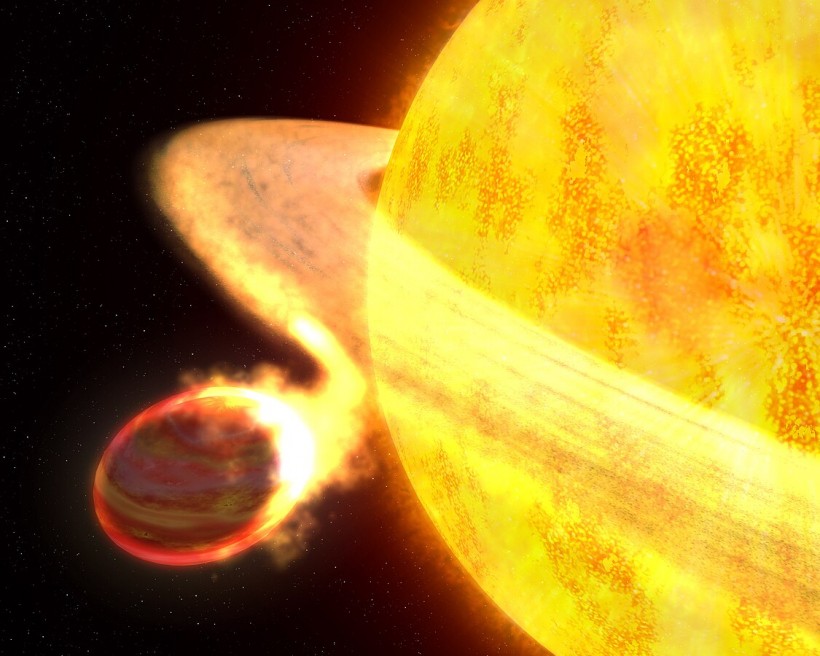An international team of scientists, led by ASTRO 3D researchers, analyzed twin stars, expecting to find identical chemical compositions. However, they were puzzled upon finding about 8% discrepancy.
In the study, titled "At least one in a dozen stars shows evidence of planetary ingestion" published in Nature, the team reports that approximately one in 12 stars exhibit signs of having consumed planets. This phenomenon suggests that disruptions in star systems by external objects, like rogue worlds or neighboring stars, can destabilize planetary orbits, leading to their ingestion by stars.

(Photo : Wikimedia Commons/NASA)
Investigating Planetary Ingestion in Twin Stars
Previous studies had noted that certain distant stars exhibited unusual levels of elements like iron, typically found in rocky planets such as Earth. This evidence hinted at the possibility of stars consuming planets, although the frequency of such occurrences remained uncertain.
To investigate planetary ingestion further, scientists turned to examining pairs of stars born simultaneously. These twin stars were expected to share nearly identical compositions since they originated from the same gas and dust cloud. Any significant differences in the chemical makeup of these "co-natal" stars could indicate that one had consumed a planet.
Using advanced telescopes like the Magellan Telescope in Chile, the European Southern Observatory's Very Large Telescope, and the Keck Telescope in Hawaii, researchers observed 91 pairs of stars. They specifically selected binary stars, as these pairs were likely to have formed with identical compositions.
The proximity of the stars within each pair-less than a million astronomical units apart-suggested they were co-natal. By comparing their compositions, researchers could identify any deviations caused by planetary consumption.
The study revealed that approximately 8% of the observed twin star pairs exhibited chemical differences, indicating potential planetary ingestion by one of the stars. Notably, these stars were in their main sequence phase, rather than being in their final stages like red giants, suggesting a distinct mechanism for planetary consumption.
Monash University's Dr. Fan Liu, lead author of the study, emphasized the significance of the study's findings, particularly the observation of planetary ingestion in stars during their main sequence phase, which differs from previous studies focusing on late-stage stars.
Exploring Implications of Stellar Appetites for Life in the Universe
Understanding how frequently stars consume planets is crucial for assessing the possibility of life in the universe and the prospects for its discovery. Meridith Joyce, affiliated with Konkoly Observatory, emphasizes the necessity of comprehending the conditions conducive to life by determining the prevalence of stars hosting planets and those that consume them.
Dr. Liu suggests that stars might engulf entire planets or protoplanetary material, adding complexity to the phenomenon. Associate Professor Yuan-Sen Ting underscores the study's significance, noting that it challenges previous assumptions and provides new insights for planet evolution theorists.
This research contributes to the broader initiative, the Complete Census of Co-moving Pairs of Objects (C3PO), aiming to observe bright co-moving stars identified by the Gaia satellite. Professor Emma Ryan-Weber emphasizes the importance of these findings in understanding the chemical evolution of the universe.
The collaboration involved scientists from various institutions worldwide, focusing on twin stars known as co-natal, born from the same molecular clouds and traveling together, although not necessarily binary stars.
RELATED ARTICLE: Tiny Black Holes Could Be Eating Stars From Their Cores Like Parasites [Study]
Check out more news and information on Space in Science Times.



![Earth's Quasi-Moon Kamo‘oalewa Could Originate From Lunar Surface Not Asteroid Belt [Study]](https://1721181113.rsc.cdn77.org/data/thumbs/full/53275/89/56/50/40/earths-quasi-moon-kamo-oalewa-could-originate-from-lunar-surface-not-asteroid-belt-study.png)










